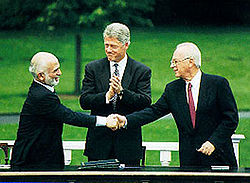Twenty Years of Israeli-Jordanian Peace: A Brief Assessment
David Schenker /Washington Istitute
October 25, 2014
The treaty’s trade and security benefits have been considerable, though many Jordanians continue to reject the likely economic windfall that full normalization could bring.
October 26 marks the twentieth anniversary of the Israeli-Jordanian peace treaty. Prior to the agreement’s signing at Wadi Araba in 1994, the two countries had not fought a war since 1967, and their leaders had been in routine communication since the 1940s. Yet the treaty was far more than just a formalization of a de facto ceasefire — it fundamentally changed the nature of the Israeli-Jordanian relationship, enhancing security, stability, and U.S. interests in a turbulent region.
For Israel, the treaty was its second with an Arab neighbor and helped secure its long eastern frontier. Coming so close on the heels of the Oslo agreements with the Palestinians, it also raised the possibility of new relationships with other Arab states. For Jordan, the agreement facilitated a reorientation away from the radical pro-Saddam camp, opening up new sources of urgently needed economic and military assistance from the West. It also cemented the kingdom’s position in the roster of pro-Western Middle Eastern states. Today, the strategic relationship with Amman is Washington’s closest with an Arab partner.
ECONOMIC AND STRATEGIC ADVANCES
While the treaty was celebrated by Israeli civilians and politicians alike, it has not been popular with the Jordanian public. In a 2011 poll, 52 percent of Jordanians said their government should cancel the agreement. Of course, some of this sentiment may simply be a cost-free way for ordinary citizens to criticize the palace, confident in the knowledge that peace with Israel is sacrosanct. Whatever the case, despite the wobbly public support for close bilateral ties, the two countries have made some progress on economic cooperation.
This progress was initially incentivized by Washington via the establishment of Qualifying Industrial Zones. Created by Congress in 1996, these QIZs allow goods produced in Jordan to enter Israel duty-free as long as they have a certain percentage of Israeli content or value added. Between 1996 and 2010, when the U.S.-Jordanian Free Trade Agreement went into effect, thirteen QIZs were established, providing tens of thousands of Jordanians with employment. As early as 2002, QIZ products were accounting for 90 percent of Jordanian exports to the United States.
Another relatively bright spot has been tourism. Last year, 218,000 Israelis reportedly visited Jordan, while just over 18,000 Jordanians traveled to Israel. To accommodate the tourists, twenty-four weekly flights link Ben Gurion, Sde Dov, and Queen Alia Airports.
Overall, however, bilateral trade has been exceedingly small. According to Israel’s Central Bureau of Statistics, imports and exports between the two states totaled just $365 million in 2013. Notably, the most dramatic development in the economic relationship occurred just last month — on September 3, Israel signed a “nonbinding letter of intent” to supply Jordan with natural gas from its offshore Leviathan field. The fifteen-year deal, which requires construction of a new pipeline, is reportedly worth $15 billion. It follows another agreement announced in February for Israel to supply $500 million worth of gas from the Tamar offshore field to two Jordanian industrial plants near the Dead Sea.
In addition to trade, the peace treaty initiated Israeli-Jordanian cooperation in a range of strategically important realms, including water scarcity. Apart from a few misunderstandings, the two countries have consistently worked together on water allocation since 1994. This culminated in the signing of an historic agreement last December stipulating that Israel would provide Jordan’s capital with 8-13 billion gallons per year of fresh water from the Sea of Galilee, while Jordan would deliver the same amount of desalinated water pumped from Aqaba to Israel’s Negev desert region.
Less publicized but equally important has been the emergence of an excellent defense and intelligence-sharing relationship. While little has been reliably published about it, intelligence sources from both countries say that the quality and depth of such cooperation is one of the treaty’s biggest achievements.
INCREASED U.S. ASSISTANCE
Once the treaty was signed, it opened the floodgates of U.S. economic and military assistance to Jordan. In 1993, Washington provided Amman with just $35 million in economic support; the 2014 figure is $700 million. Similarly, Jordan received just $9 million in U.S. Foreign Military Financing in 1993, compared to $300 million this year. Some of the bigger-ticket defense articles Washington has provided over the years include fifty-eight F-16s and a state-of-the-art counterterrorism facility — the King Abdullah Special Operations Training Center (KASOTC) — constructed by the Army Corps of Engineers in 2006-2007.
As U.S. financing increased, so did joint training and intelligence sharing. On the military front, the Eager Lion multilateral exercises became an annual affair. And according to one former CIA official quoted in 2005 by the Los Angeles Times, the intelligence partnership became so close that the agency had technical personnel “virtually embedded” at Jordan’s General Intelligence Directorate headquarters.
Yet an even more important byproduct for Jordan has been its free-trade agreement with the United States, which has had a significant impact on the kingdom’s historically feeble economy since 2010. Last year, U.S.-Jordanian trade reached $3.3 billion, a nearly tenfold increase from 1994; it jumped by over 30 percent between 2009 and 2013 alone.
OCCASIONAL DIFFICULTIES
While diplomatic relations between Israel and Jordan have generally been excellent since 1994, the treaty has periodically been tested. In 1997, a rogue Jordanian soldier killed seven Israeli schoolgirls along the border. Later that year, Israeli intelligence botched an attempted assassination of Hamas leader Khaled Mashal in Amman. Relations were again strained during the summer drought of 1999, when bilateral water talks temporarily broke down before a compromise was eventually reached.
The Temple Mount has been another point of ongoing contention. Jordanian officials have long complained — correctly — that Israel has not protected Amman’s religious equities in Jerusalem shrines as stipulated by Article 9 of the peace treaty. In the late 1990s, Israel began allowing the Palestinian Authority to supplant Jordanian religious officials in the city. More recently, the Israeli Knesset held a debate this February over allowing Jewish prayer on the Temple Mount, prompting Jordan’s prime minister to call for a “review” of the treaty. And in March, after a Jordanian Palestinian judge was killed at an Israeli border crossing, parliamentarians in Amman demanded that the government withdraw its ambassador — an almost routine response to adversity since 1994.
CONCLUSION
Twenty years on, the Israeli-Jordanian peace agreement is solid. Yet as with the 1978 Egyptian-Israeli treaty, the widespread “people to people” ties promised by Wadi Araba have not yet come to fruition. In large part, that is because a significant portion of Jordan’s population continues to oppose normalization of relations with Israel. This persistent, Islamist-tinged opposition has made it politically difficult for the palace to move forward with a broad range of political and economic initiatives. In addition to balking at mutually beneficial water sharing proposals, these opponents reject the impending purchase of Israeli gas — a deal that could provide the kingdom with energy security for decades to come. As with last December’s water deal, the gas deal will eventually be inked, but it will come at a high political cost for the palace.
Some of the anti-Israel sentiment in Jordan is no doubt related to the fact that around 60 percent of the population is of Palestinian origin. But even if Israel and the Palestinians reached a settlement of their own, it is unclear whether local attitudes in Jordan would change significantly, since the prevailing negative views of Israel are not the product of the Israeli-Palestinian conflict alone.
Amman’s close working relationship with the United States is not particularly popular in Jordan either, despite Washington’s largess. In April 2013, eighty-seven Jordanians of tribal origin — a cohort traditionally considered the monarchy’s leading supporters — penned an open letter to King Abdullah declaring that U.S. troops based in the kingdom were “a legitimate target for all honorable Jordanians.”
Yet while the population does not uniformly appreciate the treaty, the palace does, and the king will continue quietly advancing relations with Israel and Washington in the coming years. “Quietly” is the key — to avoid popular backlash, he will remain loath to advertise ongoing close strategic cooperation with Israel. In fact, during an October 20 meeting with Jordanian legislators, he tempered his critique of jihadist extremism with an equally powerful salvo against what he called “Zionist extremism.”
Finally, even with all of its accomplishments, the treaty has not been able to achieve a dramatic improvement in Jordan’s economy, which remains the Achilles heel of the kingdom’s stability. Amman’s alignment with the West and willingness to undertake difficult economic reforms have helped, but the state remains in a virtual economic crisis. Still, two decades on — at a time when Jordan is hosting more than a million Syrian refugees and continues to struggle against the tide of rising Islamic militancy — it is difficult to imagine the moderate kingdom persevering without the benefits of peace with Israel.
***David Schenker is the Aufzien Fellow and director of the Program on Arab Politics at The Washington Institute.




















